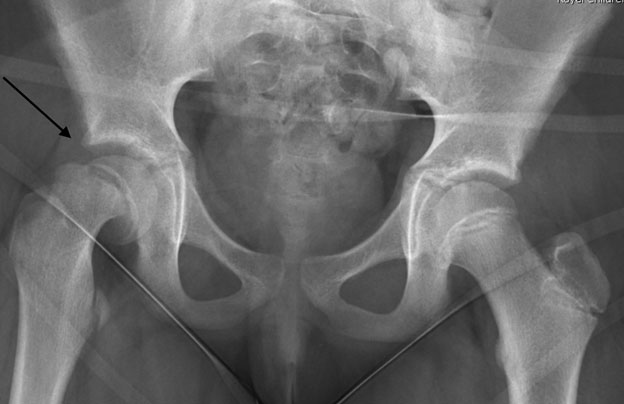Slipped Upper Femoral Epiphysis (SUFE), also known as Slipped Capital Femoral Epiphysis (SCFE), is a common hip disorder in adolescents, typically occurring during the growth spurt. It involves a displacement of the femoral head (epiphysis) relative to the femoral neck at the growth plate (physis).
- Diagnosis of Slipped Upper Femoral Epiphysis:
- Clinical Presentation: SUFE usually presents in adolescents, often those who are overweight. Symptoms include hip pain, knee pain (referred pain), a limp, or decreased range of motion in the hip. The pain is often gradual in onset but can be acute if the slip occurs suddenly.
- Physical Examination: Patients may exhibit a limp and have limited and painful internal rotation of the hip. The hip may be held in external rotation.
- Imaging:
- Plain Radiographs: Anteroposterior (AP) and frog-leg lateral views of the hip are the initial imaging studies of choice. The diagnosis is confirmed by seeing the femoral head displaced posteriorly and inferiorly to the femoral neck.
- Magnetic Resonance Imaging (MRI): Can be used if the diagnosis is unclear on plain radiographs, especially in early or mild cases.
- Management of Slipped Upper Femoral Epiphysis:
- Stabilization: The immediate goal is to prevent further slipping. This typically involves non-weight-bearing on the affected side and urgent orthopedic consultation.
- Surgical Treatment:
- The standard treatment for SUFE is surgical fixation.
- In situ pinning: The most common procedure, where a screw is placed across the growth plate to hold the femoral head in place.
- Open reduction may be necessary in severe or unstable cases.
- Postoperative Care: Involves restricted weight-bearing initially, followed by physical therapy to regain strength and mobility.
- Monitoring for Complications: Complications can include chondrolysis (cartilage destruction), avascular necrosis of the femoral head, and early-onset hip osteoarthritis.
- Bilateral Disease: Since SUFE can be bilateral, the unaffected hip is often assessed and may be prophylactically pinned, especially if it shows signs of pre-slipping.
- Long-term Follow-up: Regular follow-up is necessary to monitor for complications and to assess hip function and development.
- Lifestyle Modifications: Given the association with obesity, weight management and general health advice are important parts of management.
Early recognition and referral to an orthopedic surgeon are crucial for the optimal outcome in SUFE. Delayed treatment can increase the risk of complications, particularly the risk of further slip and avascular necrosis.

